19 April 2024
By Maynard Paton
FY 2022 results summary for Andrews Sykes (ASY):
- A record FY performance, with revenue up 10% and profit up 8% buoyed mainly by greater demand for water pumps rather than the scramble for air conditioners during the 40-degree summer.
- Bolstered by strong Italian, Dutch and Belgian progress and defying problems in France, European revenue climbed 24% and represented a record 31% of the group’s top line during H2.
- A £2m write-down of unpaid customer invoices appeared to draw a line under the group’s problematic Middle Eastern division.
- Revenue per employee reached a new £151k high although hire revenue at 1.07x the cost of hire equipment indicated no real improvement to fleet productivity.
- The accounts remain very favourable, showcasing net cash of £37m, a 26% return on equity and a 20%-or-more operating margin for 20 consecutive years. I continue to hold.
Contents
- News link, share data and disclosure
- Why I own ASY
- Results summary
- Revenue, profit and dividend
- UK
- Europe
- Middle East and Other
- Financials: hire revenue and hire equipment
- Financials: cash flow and working capital
- Financials: margin and return on equity
- Financials: pension scheme and employees
- Valuation
News link, share data and disclosure
- Annual results for the twelve months to 31 December 2022 published 04 May 2023.
- Share price: 560p
- Share count: 41,858,744
- Market capitalisation: £234m
- Disclosure: Maynard owns shares in Andrews Sykes. This blog post contains SharePad affiliate links.
Why I own ASY

- Supplies air conditioners, portable heaters and industrial pumps for hire, with success based on a prompt 24/7/365 service, high-quality rental fleet and commercial-only customer base.
- Straightforward accounts regularly showcase high margins, generous cash flow, net cash and satisfactory returns on equity.
- Chairman and family are 91%/£213m shareholders and their “presence and requirements… have resulted in a strategy with the key aim of creating long–term shareholder value” (point 2c).
Further reading: My ASY Buy report | All my ASY posts | ASY website
Results summary

Revenue, profit and dividend
- Encouraging heatwave remarks from the preceding H1…
“The second half of the year has started resiliently with record temperatures in the UK and Europe positively impacting demand for the Group’s air conditioning units and chillers. This increased summer demand leads management to be optimistic over the full-year results.”
“We knew last month had been a good one, but it has since come to light that it was our best December on record from a [UK] revenue perspective! Britain experienced snowfall, ice and bitter temperatures – and it’s fair to say our clients were cold. “
- …had already suggested this FY 2022 would report positive progress.
- FY records were set for revenue, which gained 10% to £83.0m…

- …and operating profit, which advanced 8% to £21.6m:
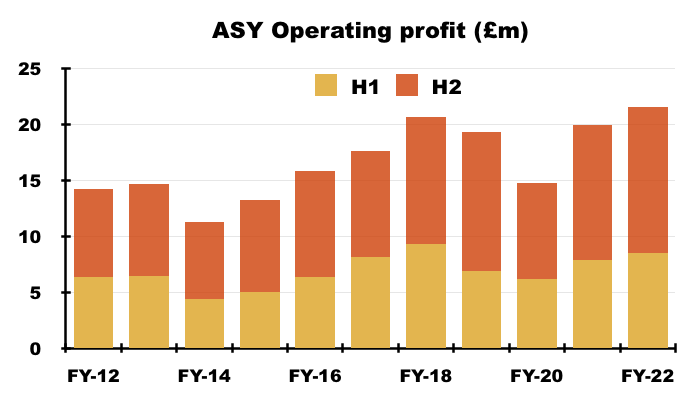
- FY operating profit could have reached £24m but for H1 restructuring costs in France of £0.5m (see Europe) and H2 debtor write-offs of £1.9m (see Middle East and Other).
- But reported profit did exclude additional pension contributions of £1.2m (see Financials: pension scheme and employees).
- This FY included the group’s best-ever H2, with H2 revenue at £45.1m, up 14%, and H2 operating profit at £13.0m, up 8%.
- Extreme weather — particularly cold snaps, heatwaves and extensive rain — typically prompt sudden demand for the group’s hire equipment (primarily heaters, air conditioners and water pumps).
- Progress from year to year can therefore fluctuate due to different climatic conditions.
- ASY referenced the 40-degree summer of 2022…
“In 2022 these extreme climate conditions, including the UK experiencing 40 degree temperatures for the first time and temperature records being broken throughout Europe, reflects the flexibility in our group businesses and their ability to adapt to circumstances and service our markets safely and securely on a sustainable basis moving forward.”
- …and its benefit to the group’s performance:
The group was well placed to take advantage of the record summer temperatures seen this year and our core traditional market of “comfort” cooling had a stand out year as a result.
- ASY’s pump-hire division enjoyed another “strong” year:
Once again, this year was supported by another strong year for our UK pump hire business, which continues the recent history of setting record levels of revenue yearly.”
- Growth rates disclosed within this FY suggest ASY’s progress is dictated more by demand for water pumps than demand for air conditioners (see UK).
- Note the comparable FY had incurred some pandemic restrictions and disclosed minor furlough income, but no Covid interference nor furlough income were declared for this FY.
- The final dividend was lifted 12% to 14.0p per share to represent the highest six-month ordinary payout since H2 2004 (also 14.0p):
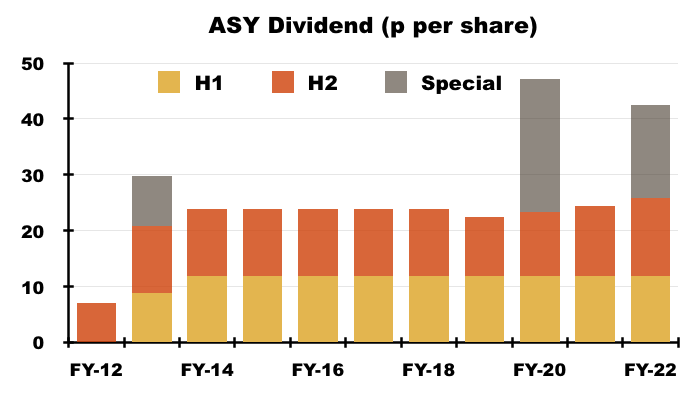
- The full-year 25.9p per share ordinary dividend was complemented earlier in the year by a 16.6p per share special payout.
UK
- ASY can trace its UK Sykes history back to the 1850s and its UK Andrews history back to the 1960s.
- The combined group today offers a trade-only nationwide rental service supplying pumping equipment, air conditioners, air purifiers, chillers, heaters, boilers, dehumidifiers and ventilation units:

- The competitive edge is based upon depots providing first-class customer service:
“By providing a premium level of service 24 hours per day, 365 days per year, we have become the preferred suppliers to many major businesses and operations spanning a huge range of industries and geographic locations. Our reputation for providing high levels of training to our staff, whilst maintaining a strict health and safety workplace, within an environmentally conscious culture, makes us an employer of choice for our industry.”
- Part of the service involves stocking the best and most relevant equipment for different clients:
“We aim to provide the most modern, technically advanced and environmentally friendly rental equipment in the market.”
“[ASY] is one of the market leaders in the rental of specialist hire equipment, offering bespoke solutions to our customers for their temporary or emergency needs.”
- This FY claimed the tip-top service combined with management experience had helped the depots sidestep a difficult economy:
“Fortunately, our strong relationships with customers and long standing relationships with key suppliers, coupled with our highly experienced management team are allowing us to once again, not only navigate our way through these [inflationary] circumstances, but thrive.”
- The UK Hire and Sales subsidiary remains ASY’s dominant division.
- For this FY, UK Hire and Sales represented 57% of group revenue and 71% of group profit, which led to a super divisional margin of 35% (£16.4m / £47.6m):
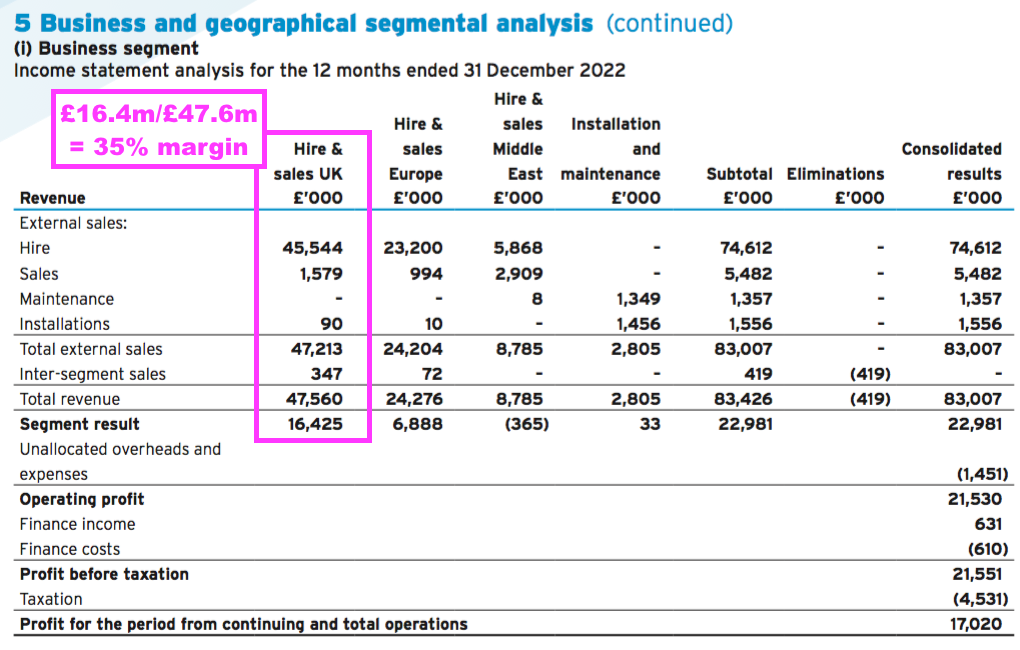
- FY revenue and profit within UK Hire and Sales gained 6-7%.
- ASY disclosed the following UK growth rates for various hire equipment:
“The UK business experienced a 4% turnover increase when compared to last year, supported by an exceptional overall year for our air conditioning division, up 36% on 2021, aided by the record temperatures experienced in the UK during 2022. We are pleased to report company turnover continues to set new records each year.
Our pump hire business continues to perform strongly with revenues achieving record levels for the fifth year in a row and are 3.9% higher than 2021.
Chiller and boiler revenues remain the most under pressure and, being 14% down on 2021.”
- UK revenue up 4% when UK air-conditioning hire revenue gained 36% implies 40-degree summers do not guarantee a sales bonanza.
- UK progress seems dictated mostly by pump hire, demand for which probably correlates to prolonged bouts of heavy rain. This FY’s 4% improvement to pump-hire revenue follows a 16% pump-hire advance for FY 2021 and a 3% increase for FY 2020.
- Chiller and boiler hire in the UK did not perform well for the second consecutive year. The 14% revenue shortfall for this FY follows a 7% revenue shortfall reported for the comparable FY.
- ASY’s main UK subsidiary accounts show UK Hire revenue advancing from £32m to £46m during the ten years to this FY — equivalent to a 3.5% compound average:
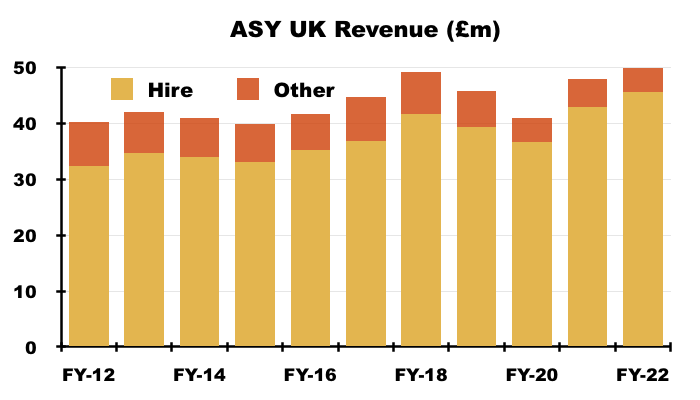

- …although oddly this FY said the main UK subsidiary operates from 22 locations:
“Our main UK trading subsidiary, Andrews Sykes Hire, has 22 locations covering the UK and employing around 300 members of staff.“
- The preceding FY reported 26 UK locations, with FY 2017 reporting 28 UK locations and FY 2013 reporting 30 UK locations.
- I don’t understand why ASY would report its UK locations declining from 30 to 22 over the last ten years when the website says customers can currently visit 32 UK depots.
- The lack of clarity over depot/location numbers is confusing, but assuming the website’s 32 is correct gives FY revenue per UK depot up an estimated 3% to approximately £1.5m (£48m/32).
- Comparing revenue to the cost of the hire equipment may be a better indicator of progress than revenue per depot (see Financials: hire revenue and hire equipment).
- ASY’s UK operations include installing and maintaining fixed air-conditioning systems, revenue from which for years bobbed around the £4m level and rarely generated a significant profit.
- Installing and maintaining such air-conditioning systems during this FY produced revenue of £3m revenue and a minimal profit:

- Total FY UK revenue gained 4% to £50.0m to represent 60% of group revenue — the lowest FY proportion for ASY’s domestic market except for FY 2018 (59%):
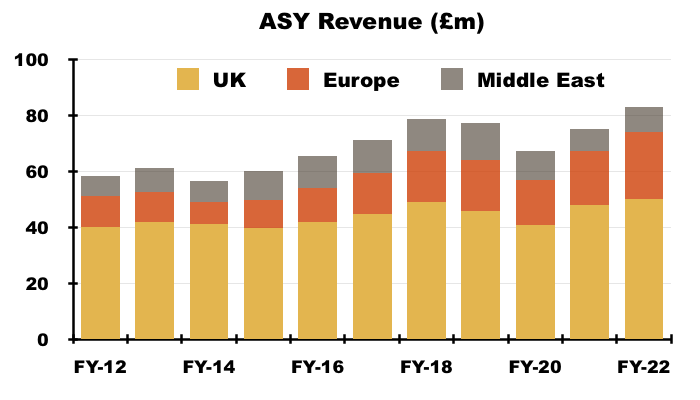
Europe
- Europe should be ASY’s main opportunity for growth.
- Between FYs 2011 and 2021, European revenue expanded from £8.8m to £19.4m to represent 26% of group sales.
- This FY then witnessed European revenue advance a further 24% to £24.2m to support 29% of group sales:

- H2 saw European revenue represent almost 31% of group sales — a record six-month proportion:
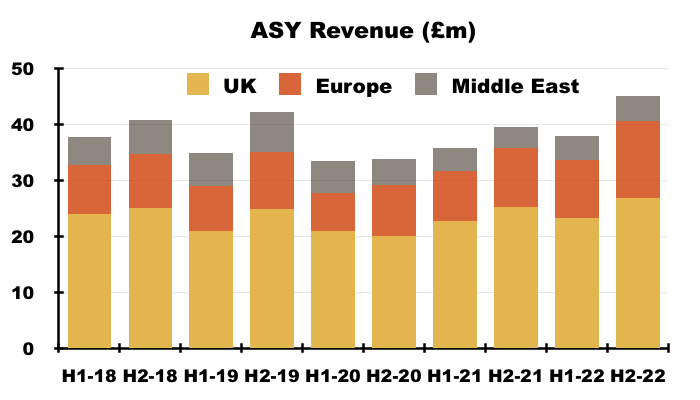
- This FY reported ASY’s European operations consisting of:
- Netherlands:
- Opened FY 1971
- 4 depots (Amsterdam, Bleiswijk, Hoogeveen, Oirschot)
- Belgium:
- Opened FY 2007
- 3 depots (Antwerp, Brussels, Kortrijk)
- Italy:
- Opened FY 2011
- 3 depots (Bologna, Milan, Verona)
- France:
- Opened FY 2012
- 3 depots (Marseille, Nantes, Paris)
- Switzerland:
- Opened FY 2013
- 2 depots (Geneva, Zurich)
- Luxembourg:
- Opened FY 2014
- 1 depot (Luxembourg)
- Netherlands:
- The preceding H1 had already signalled a £0.5m restructure within France, with the six depots reported for the comparable FY reduced to three during H2:
“Following a reorganisation during the year, we have three remaining depots in Paris, Marseille and Nantes. Despite France producing an operating loss in 2022, management continue to focus on revenue growth opportunities in order to regrow the business further and improve the operating profit performance. Turnover for 2022 finished the year 12% adverse to 2021.”
- The French restructuring looks to have continued after this FY as ASY’s website now lists only a depot north of Paris.
- Italy enjoyed a record FY buoyed by the scorching summer with revenue up 73%. Following this FY, another depot has been opened in Toscana, near Pisa.
- Other Euro markets enjoying record FYs following the hot weather were the Netherlands (revenue up 24%) and Belgium (revenue up 42%). Luxembourg revenue meanwhile gained 18%.
- ASY’s smallest European operation, Switzerland, suffered a “subdued” year with sales down 12%.
- This FY did not mention Germany, but ASY’s website now lists a depot in Frechen, near Cologne.
- I calculate a net ten European depots have opened since FY 2011 to take the region’s total to 16.
- Opening a net ten depots since FY 2011 could mean future European growth will be slow going.
- Events in France underline how promising overseas expansion — ASY opened six French depots but has since closed five — does not always lead to success.
- FY European revenue of £24.2m from 16 depots gives sales of approximately £1.5m per depot, equal to that of my UK estimate.
- The positive FY performances from Italy and Benelux ensured European profit climbed 32% to £6.9m to register a lovely 28% margin (£6.9m/£24.3m):
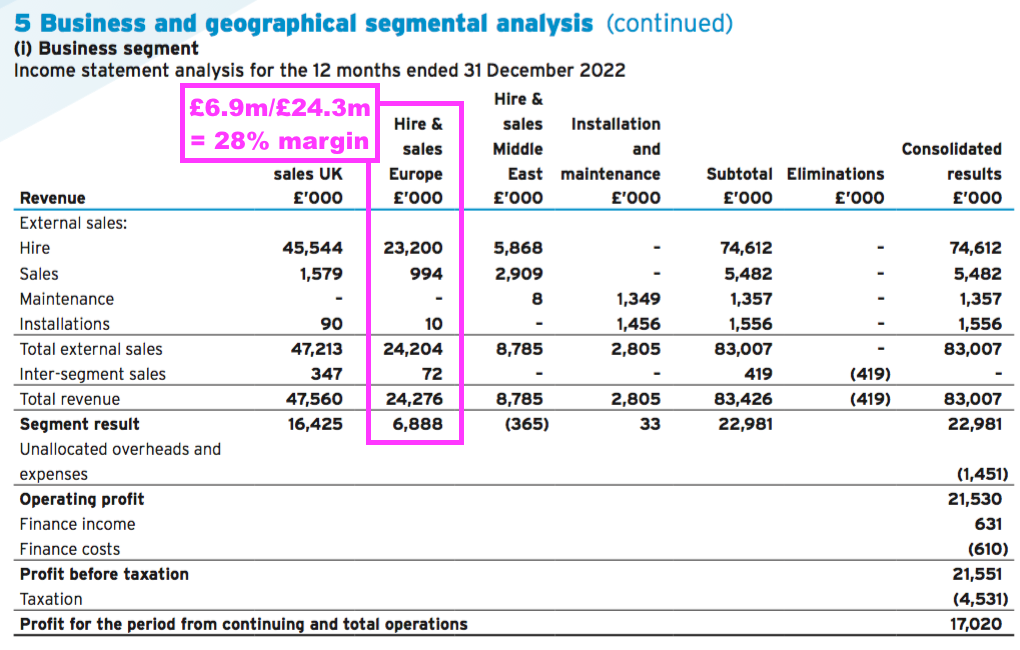
- Note that the FY European performance was hampered by greater French losses and probably minimal profit from Switzerland as well.
- The European margin therefore has scope to improve further.

Middle East and Other
- This FY appeared to draw a line under ASY’s problematic Middle Eastern ventures.
- To recap, the comparable FY had revealed Middle Eastern revenue diving 24% and divisional profit — which since FY 2015 had been running at between £2-£3m a year — collapsing to just £301k.
- The comparable FY admitted certain Middle Eastern customers had not settled their bills and contained a £1.2m provision for expected unpaid invoices:
[FY 2021] “Although still high in UK terms, the debtor day statistic in both years includes our subsidiary in the Middle East, whose debtor days were 220 days (2020: 225 days). The local economy remains badly affected by the coronavirus pandemic and slow-down in major construction projects.
Of these figures, £306,000 (2020: £456,000) of the debts written off and £1,204,000 (2020: £441,000) of the expected credit loss charge related to external debtors of our subsidiary in the Middle East.”
- The preceding H1 then referred to “increased historic bad-debt charges“:
[H1 2023] “Despite this revenue increase and a favourable exchange rate between the Dirham and Sterling, operating profit is comparable to the first half of 2021 and continues to be depressed by increased historic bad debt charges.”
- This FY then admitted a further £1.9m charge against unpaid Middle Eastern bills:
“The turnover of our hire and sales business in the Middle East has pleasingly increased from £7.9 million last year to £8.8 million; however operating profit decreased from £0.3 million to a loss of £0.4 million in the year under review. The operating climate continues to be tough in the Middle East with a lack of significant infrastructure projects still depressing turnover in the pumps division to below what was being generated a few years previous. The operating loss during 2022 is entirely down to increased expected credit losses against historic debts that are no longer considered recoverable. The credit loss charge in 2022 for the Middle East was £1.9 million.”
- ASY reckoned the £1.9m charge would conclude the Middle Eastern write-downs:
“Management [is] confident all historic credit losses are captured in the expected credit loss provision and that 2023 will see a significantly reduced credit loss and thus a return to profitability in the Middle East.“
- ASY’s Middle Eastern operations had in the past enjoyed margins of 20%-plus…
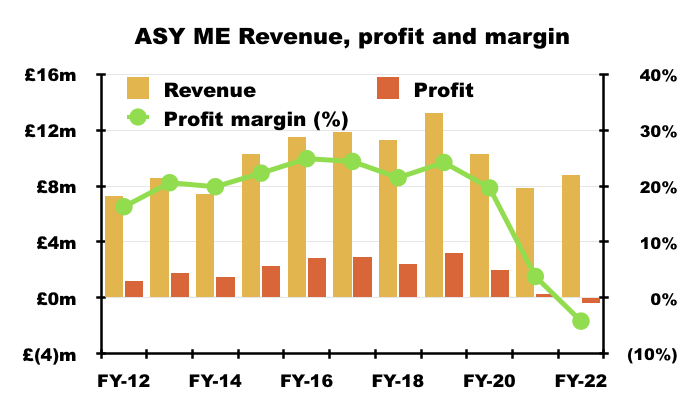
- …which presumably explains why ASY is persisting with the region despite FY Middle Eastern revenue matching levels seen ten years ago and Middle Eastern customers seemingly reluctant to pay their invoices.
- The prospects for ASY’s ‘Other’ operations — which sell, install and maintain equipment — do not appear favourable:
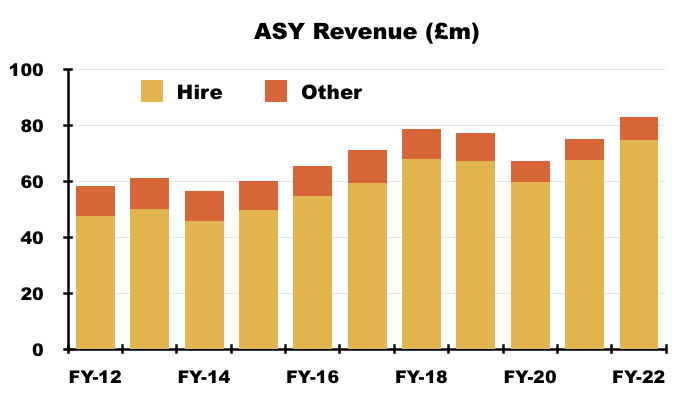
- Such revenue increased by 12% to £8.4m during this FY, but remains lower than the £10m-plus regularly recorded up to FY 2018.
- Maintenance and installation profit remains minimal:

- Profit from equipment sales are probably minimal as well (see Financials: cash flow and working capital).
Financials: hire revenue and hire equipment
- The productivity of ASY’s hire equipment enjoyed a small improvement versus the preceding FY but remains within the range witnessed since FY 2014.
- I measure hire-equipment productivity by dividing hire revenue by the historical cost of the hire equipment. Using historical cost rather than book value avoids distortions caused by depreciation rates.
- ASY employed hire equipment that averaged a £70.0m historical cost during this FY:

- Hire revenue was £74.6m:

- Hire revenue of £74.6m versus a hire-equipment cost of £70.0m gives 1.07x:

- Hire-equipment productivity greater than 1x means ASY buys equipment for hire and recoups the cost through hire fees within a year.
- Hire-equipment productivity has bobbed between 0.90x and 1.16x since FY 2014, which suggests ASY has been unable to:
- Dramatically improve utilisation of its equipment, and/or;
- Raise hire fees faster than the cost of new equipment.
- Between FYs 2006 and 2013, hire-equipment productivity ranged between 1.17x and a remarkable 1.57x.
- The much higher rates from ten years ago reflect some very impressive hire-equipment productivity outside the group’s main UK division.
- However, the impressive hire-equipment productivity outside the main UK division has since ‘normalised’ towards the main UK rate.
- For perspective, ASY’s main UK division employed hire equipment that averaged a £41.2m historical cost during this FY:

- Hire revenue at the main UK subsidiary was £45.5m:

- UK hire revenue of £45.5m versus a UK hire-equipment cost of £41.2m gives 1.10x:

- Outside of the group’s main UK subsidiary, average hire-equipment employed was £29.1m versus hire revenue of £28.8m to give 1.01x for this FY:
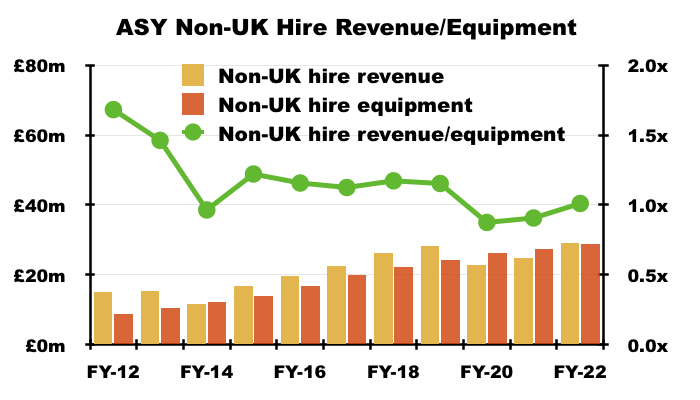
- ASY being unable to really improve its group hire-equipment productivity is not ideal, but at least the measure is reasonably consistent.
- What’s more, the high margin earned from hire revenue leads to superior returns on equity (see Financials: margin and return on equity).
Financials: cash flow and working capital
- ASY’s controlled capital expenditure and consistent working-capital management led to another FY of favourable cash generation.
- Cash flow from operations of £30m plus a £3m working-capital inflow funded tax of £4m, net capex of only £1m, other movements of £6m and dividends of £17m that left cash £5m higher at £37m:
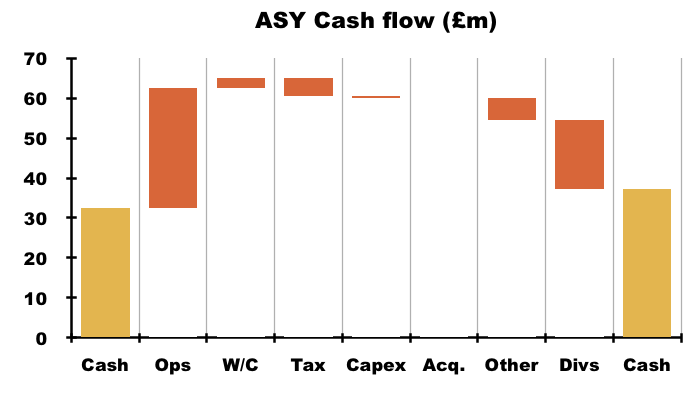
- The ‘other movements’ contained £3m to clear ASY’s remaining bank debt, which left the £37m FY cash position as the net cash position.
- Over the last five years, ASY’s cash generation has been similarly impressive:
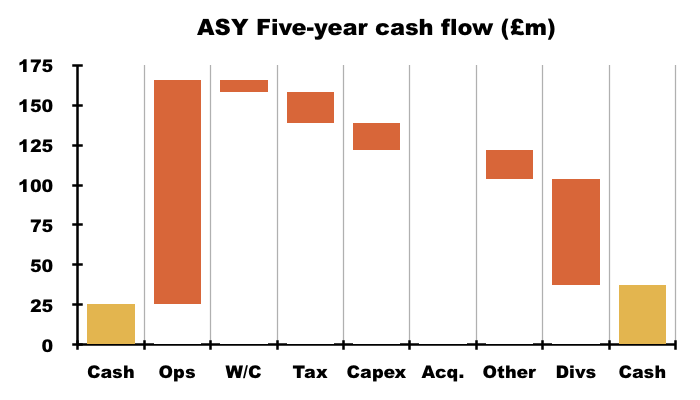
- Of the £140m cash generated from operations between FYs 2018 and 2022, £8m was absorbed into working capital, some £17m was spent on capex and a hefty £67m was distributed as dividends. A further £12m was added to the cash position.
- ASY’s cash position averaged almost £35m during this FY, and bank interest of £265k gave an effective 0.8% interest rate.
- However, H2 interest of £234k and H2 average cash of almost £36m equated to an annualised 1.3% effective interest rate:

- £17m of the £37m cash position was held as an ‘other financial asset’, which reflects cash held in a term deposit of more than three months. Cash held in such term deposits seems more likely to be surplus to the group’s day-to-day requirements and therefore more likely to be returned to shareholders:

- ASY’s capital expenditure is complicated by the group acquiring equipment for resale but then capitalising a proportion of that stock into the hire fleet:
“In addition a further £2,651,000 of items held in stock at 31 December 2021 (2021: £2,844,000 items held in stock at 31 December 2020) have been capitalised in the hire fleet this year.”
- Such stock-to-fixed-asset transfers are unusual, but presumably reflect ASY offering equipment for hire that could not be sold direct.
- Between FYs 2018 and 2022, stock with an aggregate £10m value was reclassified into the hire fleet.
- This £10m is arguably capital expenditure rather than working-capital investment, although the overall effect on cash flow is zero.
- ASY’s stock footnotes raise two other points:

- First, the cost of stock recognised as an expense of £11.2m exceeded revenue from equipment sales of £5.5m.
“The cost of stock recognised as an expense in the period was £11,167,000 (2021: £10,186,000)”
- I still can’t quite work out why stock expensed is much greater than sales revenue; the figures imply ASY sells equipment at a loss.
- Second, the £4.4m stock position is stated net of impairment provisions of £1.3m:
“Inventory is stated net of impairment provisions totalling £1,297,000 (2021: £1,386,000).
- A £1.3m inventory provision equates to a very significant 30% of this FY’s stock value and suggests ASY suffers from material levels of inventory obsolesce or damage. The figures imply £13 of every £57 invested in stock is written off entirely.
- Emphasising ASY’s generally conservative accounting, a small profit over the book value of disposed equipment has been recorded every year since at least FY 2005:
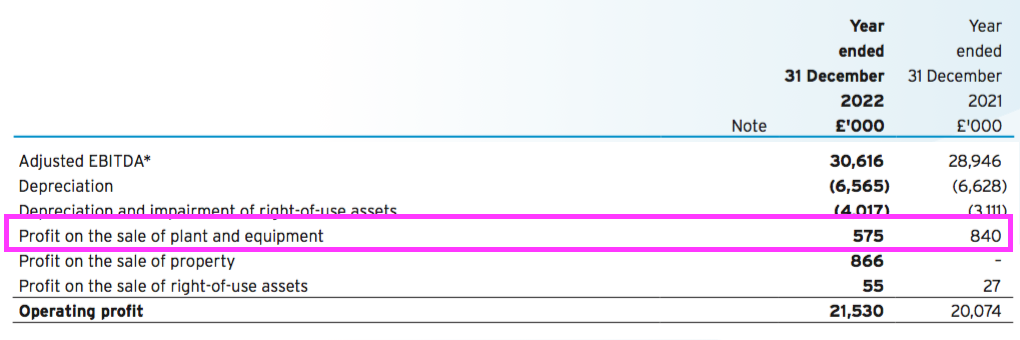
- Reflecting the aforementioned Middle Eastern invoice write-offs, net trade receivables at £17m represented 21.0% of revenue — the lowest proportion since at last FY 2006:

Financials: margin and return on equity
- The aforementioned high margins within the UK and European divisions ensured the group converted at least 20% of revenue into profit for the 20th consecutive year:

- A 22% H1 margin was followed by a 29% H2 margin to give an FY margin of 26%:
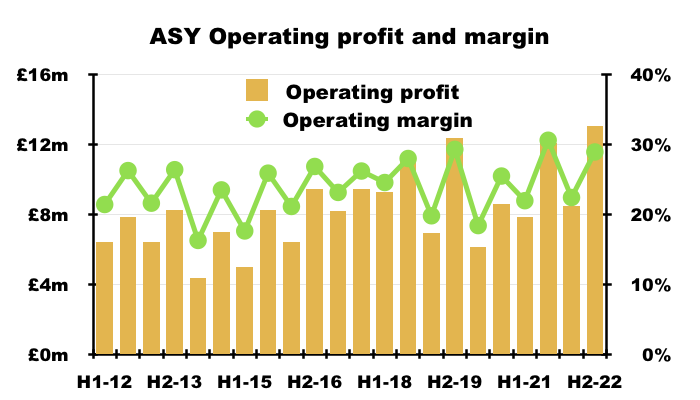
- A high margin combined with the aforementioned hire-equipment productivity leads to appealing returns on equity (ROE).
- Reported earnings of £17m versus average shareholder equity employed during the FY of £64m gives a conventional return on equity of 26%:
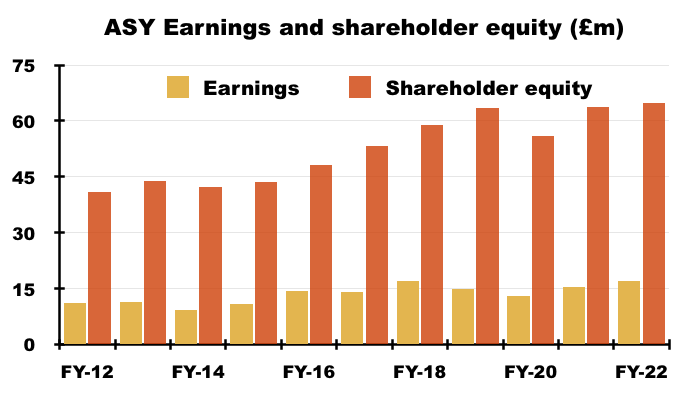
- During the five years to this FY, earnings increased by £3m while shareholder equity advanced by £11m:
- Retaining £11m to enhance earnings by £3m over five years suggests ASY reinvested its profit at a 25% return.
- Note that ASY’s largest balance sheet entry for this FY — and for the ten FYs before that — was cash:
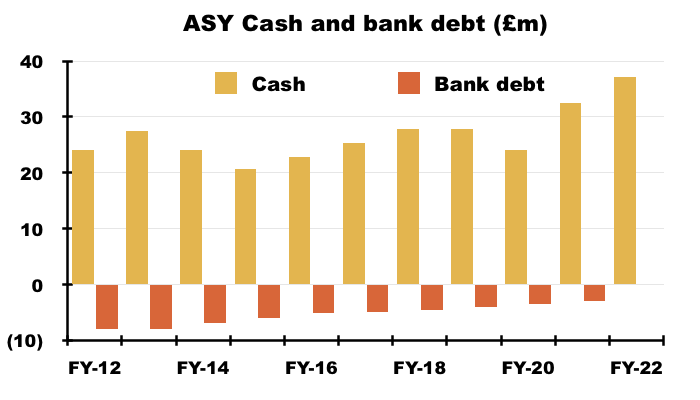
- Cash yielding 0.8% (or less) does not enhance ROE calculations.
- In fact, net cash has increased by £17m to £37m during the five years to this FY — which means shareholder equity excluding net cash declined by approximately £6m… and yet ASY was still able to enjoy the aforementioned extra earnings of £3m.
- ASY reducing its shareholder equity (excluding net cash) while simultaneously raising earnings is indicative of a very capable business.
- The only ROE ‘concern’ for shareholders is ASY retaining too much cash.
- With net cash at £37m, could yet another special dividend be forthcoming? ASY has twice declared extra payouts when net cash has reached £30m:
- During the preceding H1, which reported net cash at £31m and announced the payment of a 16.6p per share/£7m special dividend, and;
- During FY 2020, when a 23.7p per share/ £10m special dividend was declared when net cash reached £30m.
Financials: pension scheme and employees
- ASY’s defined-benefit pension scheme remains the group’s largest accounting drawback.
- This FY revealed the scheme’s surplus increasing by £2m to £8m:
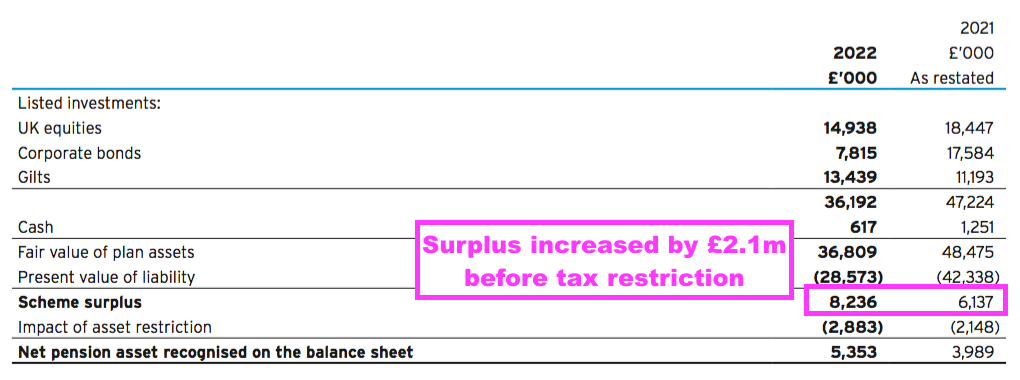
- This FY showed ASY contributing £1.3m to the scheme:

- Note that the bulk of ASY’s pension contributions bypass the income statement, with the cash flow statement highlighting the expense that is not charged to earnings:
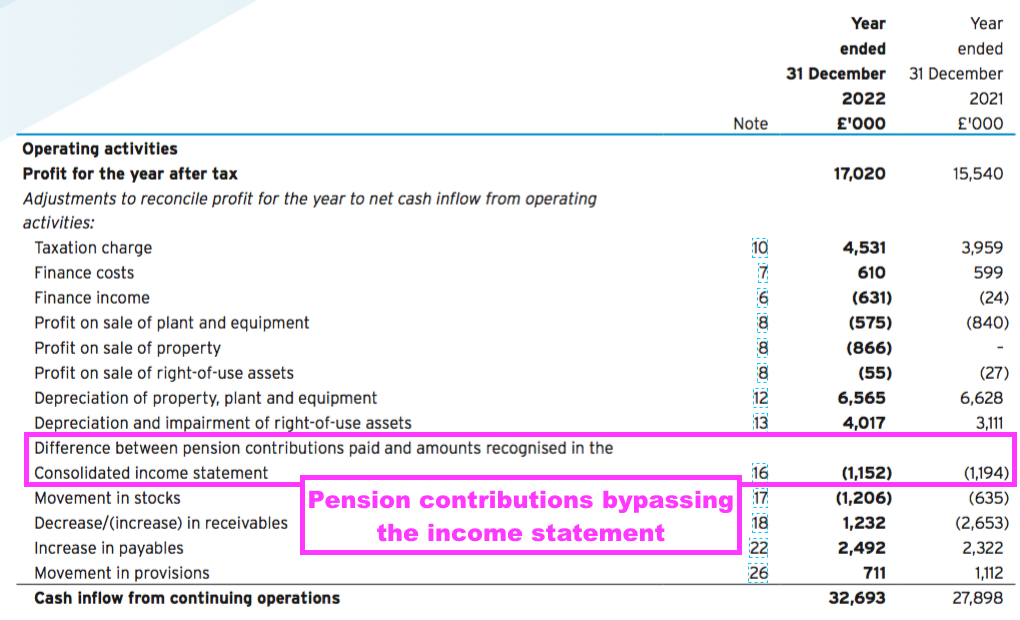
- ASY reiterated scheme contributions will drop to £120k a year for FYs 2023, 2024 and 2025:
“The last formal triennial funding valuation was as at 31 December 2019. The valuation, including a revised schedule of contributions and recovery plan, was agreed between the pension scheme trustees and the board of directors in March 2021 and was effective from 1 January 2021. In accordance with this schedule of contributions and recovery plan, the group made regular contributions of £110,000 per month for the period 1 January 2021 to 31 December 2022, and will pay £10,000 per month for the period 1 January 2023 to 31 December 2025, or until a revised schedule of contributions is agreed, if earlier. Consequently, the group has made total contributions to the pension scheme of £1,320,000 during 2022 and expects to make contributions of £120,000 during 2023.”
- A triennial funding valuation was due on 31 December 2022, the eventual recommendation from which may require ASY to contribute more than the £120k a year presently expected.
- During the ten years to this FY, scheme assets of £34m increased to £37m after investment returns of £15m and contributions of £7m were offset by benefits of £19m and admin costs of £1m:
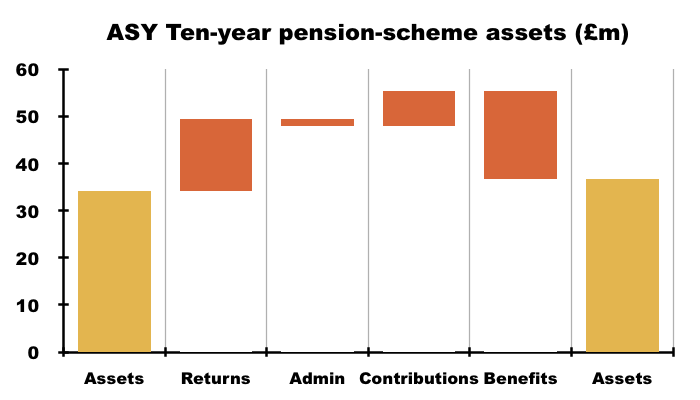
- The scheme’s ten-year history suggests contributions need to be at least maintained at their £0.7m annual average to ensure the scheme’s assets are not eroded by poor returns and/or greater member benefits.
- Scheme assets of £37m require a consistent 5.1% annual return to fund this FY’s benefits of £1.9m every year.
- This FY revealed a welcome improvement to employee productivity.
- Revenue per employee reached £151k — a new high and a break-out from the £115k-£137k range witnessed during the previous twelve FYs:
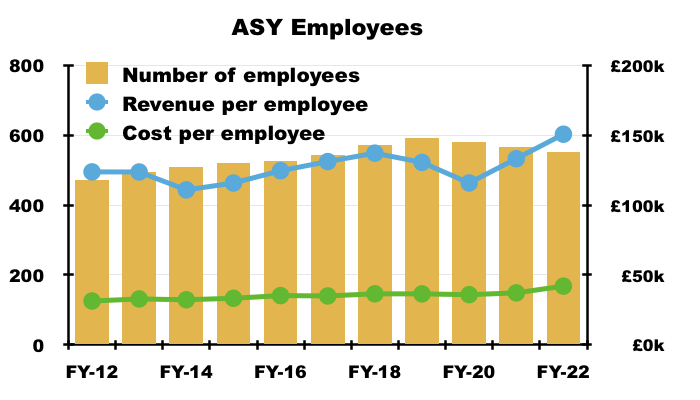
- The workforce in fact reduced by 15 during this FY after being cut by 16 during the comparable FY and by 11 during the FY before that.
- I speculate the pandemic has helped ASY find more efficient ways of working, although total staff costs continue to absorb 28% of revenue.
- ASY commendably cites revenue per employee and staff absenteeism as KPIs:

- Adopting the ‘Bradford Factor‘ helped reduce staff absenteeism:
“During the prior year, the group introduced Bradford Factor scoring in the UK, a common means of measuring worker absenteeism. In using this measure to manage absenteeism the group has reduced the staff absenteeism metric during the year. The Board [is] pleased with this reduction and would seek a similar reduction in 2023.“
Valuation
Maynard Paton

Andrews Sykes(ASY)
Publication of 2022 annual report
Here are the points of interest beyond those noted in the blog post above:
——————————————————————————————————————
1) PRINCIPAL OBJECTIVES AND STRATEGY and FUTURE DEVELOPMENT OF THE BUSINESS
No text changes for 2022. But includes a useful reminder of the group’s competitive positioning based on equipment sophistication and first-class service:
“We aim to provide the most modern, technically advanced and environmentally friendly rental equipment in the market.
By providing a premium level of service 24 hours per day, 365 days per year, we have become the preferred suppliers to many major businesses and operations spanning a huge range of industries and geographic locations. Our reputation for providing high levels of training to our staff, whilst maintaining a strict health and safety workplace, within an environmentally conscious culture, makes us an employer of choice for our industry.
Continual investment in new technology ensures that we provide our customers with new solutions to overcome their operational challenges.
We constantly review and refresh our fleet of rental equipment to ensure that we set the standards within the rental industry throughout the UK, Europe and the Middle East.
Our success has been centred on providing technically advanced climate rental and pumping products to numerous geographic locations and market sectors.”
2) KEY PERFORMANCE INDICATORS (KPIs)
A revised KPI for 2022: ‘adjusted Ebitda from continuing operations’ has been replaced by ‘operating profit from continuing operations’:
Presumably ASY believes depreciation and amortisation are now relevant to shareholders. Mind you, the associated text still refers to Ebitda:
“Adjusted EBITDA is a commonly used industry non-statutory measure used by the Board to monitor the ability of the group to generate cash.”
On revenue per employee, confirmation the improvement was due to “operational efficiencies“:
“The average revenue per employee continues to be high and indicates a strong underlying operating performance and high staff utilisation levels. The increase in the year is as a result of both increased turnover and decreased headcount driven by operational efficiencies.”
The EPS effort was described as “exceptional” for the third consecutive year:
“Achieving an EPS of 40.36 pence is regarded as an exceptional performance, bettered only in 2018.”
ASY’s KPI commentary on energy usage was kept to the following:
“The Board are pleased to see the continued efforts to operate in a more environmentally friendly way by limiting our increase in energy consumption from the previous year. ”
Revenue per kwh consumed increased from 8.58 to 8.74 for 2022 (point 9).
New for 2022 is this table reconciling the operating cash flow to operating assets KPI:
Other tables have been removed for 2022, including summaries of net interest charges, taxation and net funds. The associated text for those tables has not been included for 2022 as well. That said, ASY now carries no bank debt and the intricacies of taxation are unlikely to be a major influence on the group’s progress. Indeed, the text says:
“As the loan was paid in full during the year, narrative on interest rate reform has not been considered necessary. ”
The text does include details of the Middle East debtor position now that certain unpaid invoices have been written down:
“As well as cost control, management of working capital continues to be a priority. Whilst trading activity levels have increased, working capital has decreased by £3.2 million comparable to the prior year. Total outstanding debtor days at the year-end decreased from 78 days at the end of 2021 to 65 days at the end of the current year. Although still high in UK terms, the debtor day statistic in both years includes our subsidiary in the Middle East, whose debtor days were 70 days (2021: 220 days). During the year, management provided against historic debt, which was no longer considered recoverable. This has had the impact of significantly reducing the overall debtor days for the country. The group’s average debtor days for current unimpaired debts decreased slightly to 41 days from last year’s level of 42 days.”
3) PRINCIPAL RISKS AND UNCERTAINTIES
Strategic risks remain ‘Competitive’, ‘Technological’ and ‘Climate’, and the text contains a few revisions for 2022.
This text is new for 2022: “Our pricing is regarded as competitive to the market place.”
And the ERP upgrade mentioned in the 2021 report is now underway:
“The group is currently working through an upgrade of its existing IT systems and this will involve a new group-wide ERP system being fully rolled out over the next year.
ERP implementations are always a worry (too many go wrong).
Financial risks remain ‘interest rate’, ‘market’, ‘credit’ and ‘funding and liquidity’.
4) DEFINED CONTRIBUTION PENSION SCHEME AND AUTO ENROLMENT
Text explaining why the group’s DC pension charge climbed 47%:
“During the year the UK introduced a salary sacrifice arrangement for pension contributions meaning the employer now makes all pension contributions instead of the employee and employer making contributions. As such, the employers’ contribution rates vary from 8% to 15%. The current period charge in the income statement amounted to £1,017,000 (2021: £692,000).”
5) SHARE BUYBACKS
Probably the cheapest buyback ASY has ever undertaken, at the 1p nominal value of the shares:
“During the year the company repurchased and cancelled 26,314 ordinary shares at nominal value belonging to untraced shareholders, being shareholders who had not claimed or cashed any dividend payments from the company over a period of at least 12 years. The repurchase, which was undertaken in accordance with the company’s Articles of Association, only took place after an extensive shareholder identification and share forfeit notification process by the company. ”
6) DIRECTORS’ DUTIES AND SECTION 172(1) STATEMENT
Includes extra new text for 2022 about the importance of employees, suppliers and customers to the wider investment case:
“The group operates a training and development programme for its employees. By improving employee skill levels, the group aims to encourage staff retention and provide opportunities for internal promotion. Regular personal development reviews are conducted, with training and development plans being devised for each employee. Employees also have access to third-party assistance to provide them with support on personal issues.”
“The group recognises the need to ensure effective communications with employees to encourage involvement in the group’s performance and achieve a common awareness of factors affecting that performance. Policies and procedures have been developed to suit the needs of each subsidiary undertaking, taking into account factors such as numbers employed and location, including newsletters and communication meetings. Team talks are held regularly with departmental heads and any issues raised are noted, followed up and action taken as appropriate.”
“Externally, the group has strong relationships with a number of key suppliers, many of these relationships have been in place for 10 years or more. Regular meetings are held with these suppliers to ensure that relationships are optimised, with new innovation high on the agenda.”
“We communicate with our customers in many ways and channel feedback via a line management structure, which is much flatter than many companies within our sector. Customer communication ranges from social media through to high-level contract reviews. Customer feedback is monitored by senior management on a regular basis. Executive and non-executive directors communicate with shareholders directly and make themselves available for such meetings.”
Text also includes a useful reminder of the bias towards organic growth, the importance of the group’s equipment to the customers, the first-class service and the presence of loyal employees:
“Our business strategy prioritises organic growth. We regard customer relationships as being of the utmost importance and our key account customers, that account for approximately 50% of our business, are visited by a customer relationship manager on a quarterly basis to ensure we are meeting their expectations. The next largest group of customers (25%) are actively managed by desktop reviews supported by telephone contact, and the remaining customers accounts are subject to periodic internal reviews to ensure no issues are apparent.”
“We often provide business critical solutions to key businesses and are instrumental in helping our customers achieve their goals.”
“Our business strategy is to differentiate our services from those of our competitors by providing our customers with a first-class level of service 24 hours per day, all year round. Our reputation is among the best in the industry and means we are the employer and service provider of choice for many individuals and businesses alike.”
“The group has a large number of long serving staff members, many with 30-plus years’ service, which is a testament to our working culture. ”
7) PRINCIPAL DECISIONS TAKEN DURING THE YEAR
A new section for 2022, which indicates the board’s “principal decision” was paying the £7m special dividend:
“During the year, the Board declared and paid a special dividend of 16.60 pence per share as set out in note 32. During our engagement with investors, the level of cash held by the group was discussed and from this discussion the Board decided to return an additional £7.0 million to shareholders. In reaching this decision, the Board considered the group’s overall solvency and any potential impact on either the group’s creditors or the ability to invest in future capital additions to the hire fleet. The Board concluded that the payment of the special dividend had no material effect on the group’s ongoing business and also that there were sufficient distributable reserves to pay the dividend.
Interesting that the board refers to “engagement with investors” — 90% or so of the shares are held by the board members (see point 8)! I am not sure the other 10% hold much sway with special-dividend decisions.
8) DIRECTORS’ INTERESTS
The Murray family’s aggregate shareholding did not change during the year:
EOI Sykes Sarl is a Murray family venture.
Note that the rest of the board — the managing director and five non-execs — do not own any shares. Options were last seen in 2010.
9) SECR DISCLOSURES
ASY has definitely not joined the quoted-company trend of extolling its environmental credentials to investors through the annual report. Energy efficiency plans are limited to a handful of paragraphs:
The group used c23% less gas and electricity within the depots, but used 14% more fuel for transport:
ASY’s fuel costs for equipment delivery/retrieval are significant (see point 16).
10) CORPORATE GOVERNANCE
I am pleased ASY has decided to start publishing its corporate-governance statement within its annual report, instead of referring shareholders to its website. Publication in the annual report makes it easier for shareholders to determine any changes from year to year.
a) Application of the QCA code
Some interesting snippets.
The advantage of a “long-standing controlling shareholder“:
“Shareholder value in the medium to long term is intended to be delivered by driving operational excellence across the group and growing within selected markets and geographies. The Board believes that the presence and requirements of a long-standing controlling shareholder helps focus the company’s strategy on long-term shareholder value creation.”
The vice-chairman — not the 103-year-old chairman (see point 11) — understandably leads the board:
“The Board consists of eight members, led by Jean-Jacques Murray, the Non-executive Vice Chairman who on behalf of the Chairman, manages and provides leadership to the Board to ensure that it is effective in its task of setting and implementing the company’s direction and strategy.”
The board continues to retain just the one ‘independent’ non-exec among eight directors, a proportion that does not seem likely to change in the near future:
“There are seven non-executive directors of which one, Andrew Kitchingman, is independent. The other non-executive directors – Jacques Gaston Murray, Jean-Jacques Murray, Jean-Pierre Murray, Marie-Claire Leon, Emmanuel Sebag and Xavier Mignolet – are all associated with EOI (the company’s 86.33% shareholder) and are not considered independent. The company has only one independent non-executive director whereas the Code recommends that boards have at least two independent non-executive directors. The Board considers that there is sufficient independence on the Board taking into account the shareholder base of the company. For this reason, the Board has no current plans to appoint an additional independent non-executive director, but will keep the matter under review.”
Given the group’s financial progress, the Murray family’s agreement with ASY has to date served minority shareholders well:
“Andrews Sykes and EOI have entered into a relationship agreement (originally dated 10 December 1999 and updated on 21 September 2018) in which EOI has provided certain assurances to Andrews Sykes with regard to its relationship with Andrews Sykes. The agreement confirms that the business and affairs of Andrews Sykes shall be managed by the Board in accordance with Andrews Sykes’ Memorandum and Articles of Association and with applicable laws and all relevant statutory provisions for the benefit of shareholders as a whole.”
Further commentary suggesting the board’s membership will not change to meet corp-gov best practices:
“In recent years, the financial performance of the group has been strong, which has encouraged the Board to believe that its membership is appropriate. The Board also considers that the stability of its membership over recent years has been a major contributor to the company’s success.”
There is no formal nominations committee, its role seemingly undertaken by the vice-chairman:
“The Vice Chairman evaluates the Board performance informally on a regular basis and formally at least twice per year. The group reviews succession and contingency plans frequently and takes great care and consideration when selecting new Board members.”
Board appointments have indeed been very careful, as only two new board appointments have been made during the last ten years (the group MD and the independent non-exec).
A short line on competitor “envy” :-)
“Many companies within our market sector envy our reputation and we frequently optimise this commercially and by attracting new staff.”
b) Summary of attendance at meetings
The board does not seem overworked, with only two main meetings and one meeting each for the remuneration and audit committees:
ASY’s impressive financials do not suggest the lack of meetings has impacted the group’s progress. When I attended ASY’s 2016 AGM, I got the impression the Murray family members are very much ‘hands-off’ owners. But I do wonder if there is more engagement between the Murrays and the executive team than the two board meetings a year imply.
c) Remuneration and audit committee reports
Minimal commentary on the remuneration and audit committees:
“The Remuneration Committee comprises JJ Murray as Chair and AJ Kitchingman. The Committee reviews the performance of executive directors and sets the basis of their service agreements with due regard to the interest of the shareholders. Details of the directors’ remuneration are set out in note 9. Due to there only being one executive director, the directors consider the disclosures given in note 9 are adequate and a separate Remuneration Committee Report is not included in these financial statements.
The Audit Committee comprises AJ Kitchingman as Chair and X Mignolet. The Audit Committee is responsible for ensuring that the financial performance of the group is properly monitored, controlled and reported on. The Audit Committee considers risk and internal control as a fundamental part of its responsibilities. It meets the auditor to discuss the audit approach and the results of the audit. The Audit Committee considers the need to introduce an internal audit function each year. After taking into consideration the current size and complexity of the group, the Committee believes that it would not be cost effective to have an internal audit function and the Committee feels that sufficient control is obtained through the scope and quality of management’s ongoing monitoring of risks. As such, and given the inclusion of the Independent Audit Report on pages 26 to 33, the directors consider no addition Audit Committee Report to be required.”
d) New auditor
Mazars has replaced Grant Thornton:
“Mazars LLP, who have been appointed by the Board since the last Annual General Meeting, has expressed its willingness to continue in office as auditor and a resolution to reappoint them will be proposed at the forthcoming Annual General Meeting.
11) DIRECTORS
Chairman now 103 years old:
12) INDEPENDENT AUDITOR’S REPORT
a) Key audit matters
Various changes to the key audit matters after Mazars replaced Grant Thornton for 2022.
The previous matters were i) ‘going concern’, ii) ‘management override of controls’, iii) ‘revenue-related deductions’ and iv) ‘accuracy of pension liability assumptions’.
The matters are now i) ‘fraud risks in revenue recognition in the application of cut-off’, ii) ‘application of IFRIC 14 for the defined-benefit pension surplus’, iii) ‘expected credit losses’, and iv) ‘useful economic lives’.
‘Expected credit losses’ and ‘useful economic lives’ are welcome new matters, given the Middle Eastern debtor write-offs and the importance of the utilisation of hire equipment for the group’s underlying progress.
The new matter ‘fraud risks in revenue recognition in the application of cut-off’ reveals customers are billed at the end of the month and can presumably pay in arrears:
“We identified that there was a specific cut-off risk in relation to hire contracts commencing in December. This is because typically hire contracts have revenue recognised and billed in full on the final day of the month so we considered there to be a risk of error surrounding the revenue recognition of contracts commencing part-way through the month as an additional calculation is needed by management to pro-rata revenue accurately.”
The previous ‘revenue-related deductions’ matter investigated the correct application of rebates.
I would prefer the auditor to spend more time on the previous ‘accuracy of pension liability assumptions’ matter rather than the new ‘application of IFRIC 14 for the defined-benefit pension surplus’. After all, pension liabilities are educated guesswork and pension schemes can become ‘black holes’, so having the auditor double-check the liability assumptions would be helpful.
IFRIC 14 dictates how companies should report a pension surplus, and this 2022 report corrected an error with such reporting from 2021 (point 29). No doubt that is why the new auditor has looked closer at this matter. The auditor wrote:
“We have concluded that the application of the 35% withholding tax, that management judged to be a deferred tax, was not in line with the definition of an income tax under IAS 12. A prior period restatement has been recognised to present this tax as a restriction of the net pension surplus rather than a deferred tax liability.”
On ‘expected credit losses’, the new auditor wrote:
“Management consider the main factors in assessing the appropriate allowance for expected credit losses (ECLs) are the age of the balances held relative to the due date and the profile of the customers; past default experience; external indicators and forward-looking information. There is a level of uncertainty and hence risk that the balances may be misstated at the year- end. This requires particular focus in the UAE due to the volume of outstanding balances outside of payment terms and slow cash collection.”
That text implies the new auditor took a closer look at the debtor book and prompted management to write off the extra £1.9m owed by certain Middle Eastern customers.
The auditor’s text for ‘useful economic lives’ reveals, perhaps unsurprisingly, that the rental fleet includes a “significant amount” of hire equipment depreciated to zero but which still generates revenue:
“Property, plant and equipment is depreciated over the economic useful lives of the assets. Useful economic lives (UELs) are based on management’s estimates of the period that the assets will generate revenue, which are reviewed annually for continued appropriateness.
There are several points of judgement that management apply when setting the UELs and notably, due to various factors, there are a significant amount of hire assets held on the balance sheet at nil net book value but which are still generating revenue when required.”
The new auditor has also doubled-checked the validity of the group’s regular profits achieved from disposing of depreciated hire equipment (points 14a and 15):
“Challenging management’s assessment of useful economic lives by reviewing the fixed asset register for fully depreciated assets and analysing the gain/loss on assets that have been disposed of during the period.”
While ‘management override of controls’ was a not a key audit matter this year, the issue was considered by the new auditor:
“In addition, we evaluated the directors’ and management’s incentives and opportunities for fraudulent manipulation of the financial statements, including the risk of management override of controls, and determined that the principal risks related to posting manual journal entries to manipulate financial performance, management bias through judgements and assumptions in significant accounting estimates, in particular in relation to, revenue recognition (which we pinpointed to the cut-off assertion), and significant one-off or unusual transactions.”
b) Materiality and scope
Audit materiality is the standard 5% of pre-tax profit. The full-scope audit proportions were similar to last year, with the main UK subsidiary, the Netherlands and Khansaheb Sykes in the Middle East under the greatest scrutiny:
“Full scope entities represented 82% of group revenue, 80% of group profit before tax, 72% of group total assets and 84% of net assets. This increases to 100% of all these measure when including entities subject to limited review.”
13) GOING CONCERN
ASY commendable gives an insightful ‘going concern’ note. No assumption changes from 2021 for the “reasonable worst-case trading scenario“, and the group could survive if revenue suddenly dropped below £50m:
“Whilst profitability and cash flow performance to the end of March 2023 has been close to expectation, in order to further assess the company’s ability to continue to trade as a going concern, management have performed an exercise to assess a reasonable worst-case trading scenario and the impact of this on profit and cash. For the purposes of the cash forecast, only the below assumptions have been incorporated into this forecast:
● Normal level of dividends will be maintained during the 12 months subsequent to the date of approving the accounts;
● No new external funding sought;
● Hire turnover and product sales reduced by 12% versus budget – a variance level seen across any individual product class for 2022 and 2021 actual results versus budgets;
● All overheads continue at the base forecast level apart from overtime and commission and repairs and marketing, which are reduced by 5% and travel costs reduced by 2.5%;
● All current vacancies are filled immediately; and
● Capital expenditure is reduced by 5%.
The above factors have all been reflected in the forecast for the period ending 12 months subsequent to the date of approving the accounts. The headline numbers at a group level are as follows:
● Group turnover for the 12 months ending 31 December 2023 is forecast to be adverse to the 31 December 2022 figures. Operating profit is below the profit for 2022.
● Closing net funds as at the end of May 2024 are forecast to be below the level reported at 31 December 2022.
Under this reasonable worst-case scenario, the group has sufficient net funds throughout 2023 and up to the end of May 2024, to continue to operate as a going concern.
A final sensitivity analysis was performed in order to assess by how much group turnover could fall before further external financing would need to be sought. Under this scenario it was assumed that:
● Capital expenditure falls proportionately to turnover;
● Temporary staff are removed from the group; and
● Various overheads decrease proportionately with turnover.
Given these assumptions, and for modelling purposes only, assuming dividends are maintained at normal levels, group turnover could fall to below £50 million on an annualised basis without any liquidity concerns.”
14) SIGNIFICANT ACCOUNTING POLICIES
A few minor changes here, seemingly prompted by the new auditor and the new key audit matters (see point 12a).
a) Property, plant and equipment
A change of depreciation rates for ‘Heating, air conditioning and other environmental control equipment’ for hire. The old rate of 20% is now replaced by rates between 14% to 33% — so useful lives of between 3 and 7 years.
‘Pumping equipment’ for hire retains depreciation rates of between 10% and 33% — indicating some pumps last for 10 years.
A new line for 2022:
“Profit on the sale of plant and equipment are ad-hoc transactions and do not constitute a separate line of business.”
After evaluating the regular profits on disposals of depreciated equipment, the new auditor may have considered this activity to be a genuine trading activity (points 12a and 15).
b) Revenue
New text clarifying the effect of rebates and expected credit losses on revenue:
“Any rebates are treated as variable lease income and recognised in the income statement when it is earned;”
“Rebates are recognised as a separate liability to reflect the method of settlement and included as a component of accruals (see note 20). This balance also includes separate rebates for hire revenue whereby recognition and measurement criteria have been met under IFRS 16. The Group reviews its estimate at each reporting date and updates the liability accordingly.”
“For all categories of revenue, the amount of revenue recognised is also adjusted for the expected credit losses. These amounts are determined based on past default experience, external indicators and forward-looking information performed on an entity-by-entity basis and not a collective basis.”
c) Other financial assets
Introducing ‘other financial assets’ that reflect cash tied up for more than three months:
“Other financial assets comprise amounts of cash that the Group has on deposit with a maturity date in excess of three months from the date of initial deposit.”
15) USE OF CRITICAL ACCOUNTING JUDGEMENTS AND ESTIMATES
Various changes here, not least omitting this line from 2021 for this 2022 report: “The directors do not consider there to be any critical judgements.
I presume the directors now consider there to be critical judgements. I suspect the new auditor has become involved here.
Anyway, the new text includes:
“Pension scheme surplus recoverability
When assessing the appropriateness of the recognition of a surplus, the directors have considered the guidance in IAS 19 and IFRIC 14, and have concluded that because of the unconditional right to recover the related net surplus upon wind-up, and the expected manner of recovery of any surplus is via a refund, it is appropriate to recognise the asset in the consolidated financial statements. When assessing the valuation of the surplus, the directors have recognised any associated tax as an asset restriction.”
“Incremental borrowing rate for leased assets
The group operates from a large number of leased premises throughout its entire geographical footprint. In addition, the group chooses to lease its fleet of motor vehicles to allow operational flexibility. Each of these leases is subject to an incremental borrowing rate used to calculate the right-of-use liability and asset value. Given the group operates in different legal jurisdictions and does not have any direct borrowings in all of these jurisdictions, there is an element of estimation in determining the applicable incremental borrowing rate that is applicable. The incremental borrowing rate used is based on indicative rates provided by the group’s bank.
If the incremental borrowing rate was increased by 1% the interest charge would increase by approximately £10,000 and the value of the right-of-use additions during the year would increase by approximately £0.1 million. A 1% reduction in the incremental borrowing rate would decrease these amounts by a similar amount.”
New text for 2022 also includes insightful commentary on repair costs and why equipment with a zero book value is kept on:
“The group incurs maintenance spend in order to keep its fleet to a high level of repair, which often extends an individual assets life beyond its useful economic life. During the year, the group incurred £2.2 million of repair costs. More substantial parts, such as replacement parts, are capitalised, with the asset also removed from the fixed asset register. To provide sufficient asset availability for periods of extreme weather, the group routinely keeps nil net book value items rather than scrap them.”
Ah-ha, this new text for 2022 below reveals why hire equipment is sold and refutes speculation about their book value being too conservative (points 12a and 14a):
“The profits on the disposal of hire assets represent occasional requests to sell hire assets, often to an existing customer, and are not considered by management to indicate that there is positive residual value in the entire hire assets portfolio. The group also considers market-based evidence from other comparable industry competitors when assessing the useful economic life of its assets.”
16) PROFIT BEFORE TAXATION
ASY commendably continues to list all of its expenses:
I note ‘vehicle and travel costs’ climbed 36% to £5.4m (point 9), ‘professional services’ climbed 56% to £2.4m and ‘IT and communication’ climbed 39% to £1.6m — the new ERP system? (point 3).
The new auditor charged £251k — up 20% on 2021’s £209k bill. Versus revenue of £83m, £251k for the audit is not huge (more here).
As well as profit on sales of hire equipment, 2022 also witnessed profit on disposals of property (£866k, point 19) and right-of-use assets (£55k), which again underpin the notion of conservative accounting.
‘Rehire costs’ suggests ASY does not always have the right equipment to hand for customers.
17) EMPLOYEES
As per the blog post above, employee productivity — as measured by revenue per employee — reached a new £151k high:
The workforce has changed somewhat over the last ten years. The number of people employed in ‘sales and distribution’ has increased by only 4 to 166 (+2%), while the number employed as ‘engineers’ has increased by 43 to 242 (+22%) and the number of ‘managers and administration’ is up 32 to 143 (+29%). Clearly efficiencies made with sales and distribution have been offset by extra managers and admin staff.
The average wage last year was £35k, up 10% and some way above the £30k-£32k witnessed since FY 2016. Average total staff cost was £42k. I am hopeful staff utilisation can remain high to offset what seems to be significant employee wage inflation.
Redundancy costs have been charged every year since at least FY 2006, suggesting ASY likes to regularly trim the workforce. The £278k redundancy charge for 2022 was the largest since FY 2006 (£641k).
Pension costs are now 5.2% of wages versus 3.8% for 2021 (point 23).
18) DIRECTOR EMOLUMENTS
The managing director enjoyed a 15% advance to his combined pay and bonus to £469k:
He does not seem outrageously paid for a business making a £22m profit and boasts impressive cash generation. The MD’s predecessor collected £528k during FY 2018, which was also (at the time) a record year for the group bolstered by a very hot summer.
Three of the non-execs, including the 103-year-old chairman, did not take a fee last year. The non-exec fees that are paid seem modest, but remember the non-execs attended just four meetings at most last year (point 10b).
19) PROPERTY, PLANT AND EQUIPMENT
Freeholds are in the books at £3.4m:
My interpretation of the notes suggest the book value of the property disposed was (£685k cost less £493k accumulated depreciation) = £192k. Which, if accurate(!), makes the sold property actually worth £1,058k if the book profit was £866k (point 16)! Are ASY’s other freehold properties valued so conservatively?
20) RIGHT-OF-USE ASSETS
Ah — some clarity on the write-offs from France and other restructuring that I missed from the blog post above:
“During the year, the group has undertaken an impairment review of its right-of-use asset and has identified two events that have given rise to an impairment loss. As disclosed in note 26, the UK business has undertaken a restructuring exercise during the year resulting in the relocation of four locations into one larger consolidated site. The exit from these four locations has lead to onerous leases, and in turn, the impairment of the associated right-of-use asset, which now have no economic value to the group. An impairment amount of £289,000 relating to property assets has been charged against administrative expenses during the year in relation to this.”
“In addition to the above, during the year our French subsidiary, Climate Location SAS, ceased trading from three depot locations. Property right-of-use assets associated with these three depots of £531,000 have been impaired as a result of this exit due to no future economic benefit expecting to be generated by these assets. In addition, due to the continued operating losses generated by Andrews Sykes Climat Location SAS, the group has decided to impair £147,000 of motor vehicle right-of-use assets and £29,000 of plant and machinery assets.”
So £289k + £531k + £147k + £29k = £996k of arguably one-off write-downs.
The text about the “relocation of four locations into one larger consolidated site in the UK might explain some of my location/depot number confusion.
21) SUBSIDIARIES
The arrangement with Khansaheb Sykes is all a bit strange, with ASY owning 49% but accruing 100% of the venture’s profit (although how much profit does Khansaheb Sykes make?):
“With the exception of Khansaheb Sykes LLC, the group holds 100% of the issued share capital of its subsidiaries. Whilst the group only holds 49% of the issued share capital of Khansaheb Sykes LLC, this shareholding entitles the group to 90% of the profits for the period and control of the company by virtue of the right to appoint the majority of the company’s directors. The 51% shareholder has waived his right to receive the 10% profit share and, therefore, the group has consolidated 100% of the company’s result for the period.”
22) RETIREMENT BENEFIT PENSION SCHEMES
The pension scheme’s investments altered significantly during 2022, with corporate bonds down 56% in value to represent 21% of the scheme’s assets — the lowest since FY 2007 (11%):
Equities meanwhile now represent 41% of the scheme’s assets — the highest since FY 2006 (57%). Gilts now represent 37% of the scheme’s assets — the highest since FY 2008 (34%):
Looks as if the pension fund has switched to gilts from corporate bonds now that higher yields have become available on such ‘risk-free’ assets.
This line might suggest the pension scheme is relatively mature:
“The weighted average duration of the pension scheme liabilities is 14 years (2021: 16 years).
But the cited duration has bobbed between 14 and 16 years since FY 2017, when the information was first disclosed. The scheme was closed to new members at the end of 2002 and I dare say the payment of member benefits may continue beyond 2060.
23) DEFINED CONTRIBITION PENSION SCHEME
Further info on the salary-sacrifice arrangement. I don’t know why the figures contained within this note differ to the £1,017,000 (2021: £692,000) cited elsewhere within this annual report (points 4 and 17):
“During the year the UK introduced a salary sacrifice arrangement for pension contributions meaning the employer now makes all pension contributions instead of the employee and employer making contributions. The amount varies, generally based upon the individual’s seniority and length of service with the company.
Contributions for both existing members and members that have been auto enrolled are made to the same scheme. The employer’s contribution rates vary from 3% to 15%, the current average being 5.2% (2021: 3.5%). The current period charge in the income statement amounted to £689,000 (2021: £446,000).”
24) TRADE AND OTHER RECEIVABLES
ASY (or the new auditor — point 12a) has lifted the ‘expected credit loss’ percentage for invoices that are 3 or more months past due:
The percentages can change from year to year as credit quality of the customers can improve or deteriorate. But I would like to think that, after the £1.9m write-down of certain Middle Eastern debtors, ASY continues to take the view that any invoice more than 12 months overdue will not be repaid.
25) OTHER FINANCIAL ASSETS and CASH AND CASH EQUIVALENTS
Details here about the interest received on cash:
A bit sad that ASY employed “interest-free” bank current accounts — and has stashed £13m in such accounts! The money held in deposit accounts earned 1.3%. I am hopeful ASY’s 2023 figures show greater rates of interest!
26) TRADE AND OTHER PAYABLES
Reflecting tight cash control, total trade and other payables reached a £17m high:
Trade and other payables were equivalent to 20.0% of revenue, the highest percentage since FY 2004 (21.6%). Greater accruals (general expenses recognised by not yet paid) underpinned the improvement. The difference between total receivables and total payables is £2.8m, the lowest since at least FY 2003 and another sign of good cash control.
I await to see whether the higher level of payables is due to favourable short-term issues and will unwind during FY 2023, or is instead a step-change in cash control.
27) PROVISIONS
More commentary of the relocation of four UK sites into one:
“Restructuring provision relates to the relocation from four locations in the UK to one large consolidated site and the associated costs involved including expected move costs and redundancy. It is anticipated that the majority of these costs will be incurred during 2023. The impact of discounting is considered immaterial to the amounts provided. The final actual cost is uncertain and based on the outcome of potential redundancy consultations, as well as the final actual move costs. The current provision is based on best estimates.”
The £672k restructuring provision covers expected moving costs and redundancies, and therefore looks to be in addition to the £289k relocation right-of-use asset write-down (point 20).
It seems 2022 profit was dampened by both this £672k provision and the total £996k right-of-use asset write-downs.
28) FINANCIAL INSTRUMENTS
Nothing too untoward here. With overseas sales representing c30% of total revenue and growing, currency movements may soon have a greater influence on overall group progress. ASY does not undertake any special FX hedging:
“The group’s policy is not to hedge its international assets with respect to foreign currency balance sheet translation exposure, nor against foreign currency transactions. The group generally does not enter into forward exchange contracts and it does not use financial instruments for speculative purposes.
No entities within the group hold significant financial assets or financial liabilities in a currency that is different to their functional currency and, therefore, there is no material exposure to currency risk.”
29) PRIOR PERIOD ADJUSTMENT
Details of the pension-scheme tax restatement (point 12a):
“Following an internal review of Andrews Sykes Group plc’s compliance with certain technical aspects of both IFRIC 14 and IAS19, the group has restated certain balances previously reported. Following the review it has been determined that the previously recognised deferred tax liability held against the defined benefit pension scheme surplus meets the definition of an asset restriction.”
The tax related to the scheme’s surplus was amalgamated into the scheme’s accounting entry, rather than reported as a deferred tax liability (which concerns tax on trading activities).
Maynard